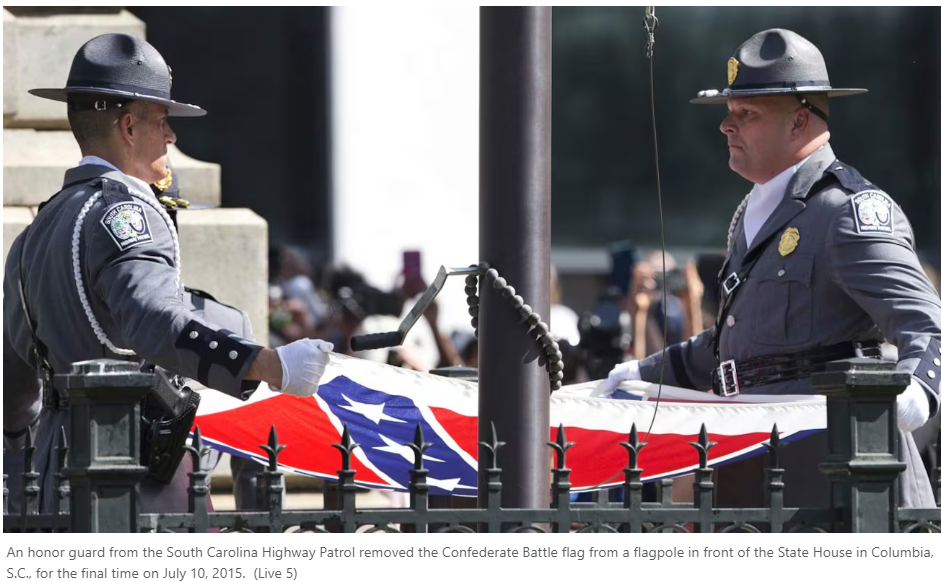ALBEMARLE, N.C. — Are secret documents dating back to the Civil War buried in a mine in Stanly County?
The Stanly County Museum and Stanly County Historical Society gave local residents an opportunity to hear of the mystery surrounding the disappearance of the lost archives of the Confederate States of America last Thursday.
Historian and West Stanly High School U.S. Air Force JROTC instructor Major Ralph P. Ganis told the story of Jefferson Davis’ flight south following the collapse of the Confederacy and the possible fate of the Confederacy’s archives somewhere in the Yadkin Valley.
Ganis gave his presentation, “Final Orders: The Secret Mission to Stanly County to Protect the Archives of the Confederacy, April 1865,” at he New London Fire Station.
“Tonight I’m going to talk about records that were saved and records that were lost,” Ganis said.
The information presented during the program, Ganis said, came from research he had conducted and then later set aside for approximately seven years. He noted that he didn’t have definitive answers to the fate of the archives, but he believed that through his research, he has come to possess part of the story.
Following a brief overview of the final days of the Civil War, Ganis spoke of the Confederate States of America’s attempt to move its seat of government and its archives.
“The writing was on the wall and they could see the end coming,” Ganis said, adding that on April 2, the Confederate government began to evacuate the capitol in Richmond, Va. The Confederacy, like most governments, possessed a lot of paperwork. Its archives, therefore, were extremely important.
In order to understand what would come later, Ganis explained that it was important to delve into the mindset of the individuals at that point in time.
“The Confederacy was once a nation,” Ganis said.
“The men and women of the South, they loved their country.”
The Battle of Appomattox Court House on April 9, 1865, however, would bring the definitive blow to the Confederate army. At the conclusion of the battle, Gen. Robert E. Lee, would surrender the Army of Northern Virginia to the Union army. Ganis noted that despite Lee’s surrender of the bulk of the Army of Northern Virginia, there were still troops in the field.
“General Lee did not surrender his entire army. He only surrendered the infantry and artillery,” Ganis said.
Confederate Calvary Major Gen. Thomas L. Rosser was able to escape with his men following the battle and attempted to reorganize and meet up with Joseph E. Johnston’s army in North Carolina.
“They were intending to reconstitute. They had no intentions to surrender,” Ganis said.
Davis, who served as president of the Confederate States of America, made his escape to Sutherlin Mansion in Danville, Va. Shortly thereafter, he would continue his retreat south to Greensboro.
“While all this was going on there are generals still in the field who continue to fight,” Ganis said.
Capt. John Taylor Wood, nephew and personal aide of Davis, handled records pertaining to the executive department. As Davis’ family member and aide, Wood, who had a residence in Greensboro, was entrusted with the secret papers of the Confederacy.
“He was privy to the deepest secrets of the Confederacy,” Ganis said.
Ganis said that train cars were loaded up with government records and sent south to escape Union capture. Stanly County, he said, was just off the trail of where the main rail line was heading.
“Davis was trying to make it to Texas and link up with Gen. Kirby Smith and continue to fight,” Ganis said.
Ultimately, many records were either burned along the way or fell into the hands of the United States government or individuals.
“State Department records were sent to Danville Female Academy,” Ganis said, adding that 80 boxes of records were also found and turned over the U.S. military and 128 quartermaster records are currently in the national archives.
“Other records were found all along the route.”
While some documents have been located, some are still missing, as in the case of the records of the Confederate States Marine Corp.
“Historians have been unable to locate any of the records,” Ganis said.
Stanly County, however, may hold the answer to the mystery.
According to Ganis, Major Richard Taylor Allison, a first cousin of Wood, was on one of the trains headed south. Allison kept a diary and in a journal entry dated April 16, he noted that he was at Crowell Mine, located near the town of New London.
“Major Allison brought something here during his retreat to Stanly County,” Ganis said.
To add support to his theory, Ganis read an excerpt from a writing by Edward Alfred Pollard, an American journalist who died in 1872.
In the excerpt, Pollard wrote that the bulk of valuable Confederate papers exist in concealment and were deposited in a place where they would remain in concealment, not to be “unearthed” within his generation.
“Records were brought here,” Ganis said, adding that at minimum they are the archives of the Confederate States Marine Corp.
At the conclusion of his presentation, Ganis challenged anyone to take up his research and see where it takes them.
Ganis was born in Southern Pines and served in the U.S. Army, Air Force and Marines. He obtained a degree in history from the University of North Carolina at Charlotte. He has master of science and strategic intelligence from the Defense Intelligence Agency. He is the author of two books on Jesse James.
–Stanley News & Press



